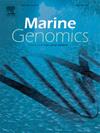窦弧菌的全基因组序列,胶原降解的潜在贡献者
IF 1.5
4区 生物学
Q4 GENETICS & HEREDITY
引用次数: 0
摘要
胶原酶是一种酶,已被证明对天然三螺旋胶原及其变性形式(如明胶)的降解都非常有效。作为致病菌(溶组织梭状芽孢杆菌、弧菌、蜡样芽孢杆菌)分泌的毒力因子,这种功效归因于该酶在热稳定的纤维结构中水解Gly-X-Y键的独特能力。从福建省东山湾采集的表层海水中分离到一株高效降解明胶的弧菌S4M6T,但降解明胶的关键基因尚不清楚。在此,我们报道了窦弧菌S4M6T及其胶原降解基因的全基因组序列。菌株S4M6T基因组由两条圆形染色体组成,染色体总长度为4.78 Mbp, GC含量为43.4%。基因组分析显示,菌株S4M6T编码一个参与胶原降解的胶原酶基因。本研究提供了海洋弧菌物种胶原降解的遗传见解。本文章由计算机程序翻译,如有差异,请以英文原文为准。
Complete genome sequence of Vibrio sinus, a potential contributor to collagen degradation
Collagenase is an enzyme that has been shown to be highly effective in the degradation of both native triple-helical collagen and its denatured form (e.g., gelatin). As a virulence factor secreted by pathogenic bacteria (Clostridium histolyticum, Vibrio, Bacillus cereus), this efficacy is attributed to the unique ability of the enzyme to hydrolyze Gly-X-Y bonds within thermally stable fibrillar structures. A highly efficient gelatin degrading strain, Vibrio sinus S4M6T, was isolated from the surface seawater collected in Dongshan Bay (Fujian, PR China), but the key genes involved in gelatin degradation remain unknown. Here, we report the complete genome sequence of Vibrio sinus S4M6T and its collagen degrading genes. The genome of strain S4M6T consists of two circular chromosomes, with a total chromosome length of 4.78 Mbp and a GC content of 43.4 %. Genomic analysis revealed that strain S4M6T encodes a collagenase gene involved in collagen degradation. This study provides a genetic insight of collagen degradation in marine Vibrio species.
求助全文
通过发布文献求助,成功后即可免费获取论文全文。
去求助
来源期刊

Marine genomics
生物-遗传学
CiteScore
3.60
自引率
5.30%
发文量
50
审稿时长
29 days
期刊介绍:
The journal publishes papers on all functional and evolutionary aspects of genes, chromatin, chromosomes and (meta)genomes of marine (and freshwater) organisms. It deals with new genome-enabled insights into the broader framework of environmental science. Topics within the scope of this journal include:
• Population genomics and ecology
• Evolutionary and developmental genomics
• Comparative genomics
• Metagenomics
• Environmental genomics
• Systems biology
More specific topics include: geographic and phylogenomic characterization of aquatic organisms, metabolic capacities and pathways of organisms and communities, biogeochemical cycles, genomics and integrative approaches applied to microbial ecology including (meta)transcriptomics and (meta)proteomics, tracking of infectious diseases, environmental stress, global climate change and ecosystem modelling.
 求助内容:
求助内容: 应助结果提醒方式:
应助结果提醒方式:


